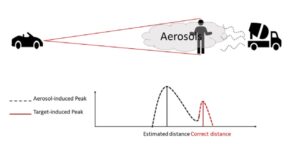LiDAR has become a key component of sensor suites for autonomous vehicles due to its indisputable precision and high performance. However, the high cost of LiDAR and the sizable performance degradation under severe operating conditions are issues to be addressed before its large-scale deployment is possible. We, as a part of the LiDAR team, intend to make contributions in three directions. First, based on the thorough understanding of components of the SPAD LiDAR without moving parts, we will develop advanced ranging and 3-D point-cloud generating method, taking full advantage of the detailed characterization of each components and the introduction of computational imaging methods. Second, we will develop advanced algorithms to mitigate the performance degradation due to harsh operation conditions, based on the physical models of fog (smoke) and the introduction of computational imaging methods. Third, we will actively participate in system integration and continue to promote the cooperation and fusion among ranging/point-cloud generation methods and smart technologies such as object recognition in LiDAR applications.
